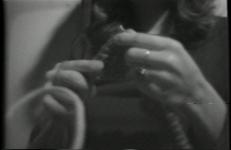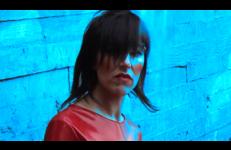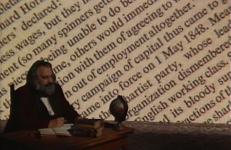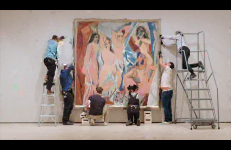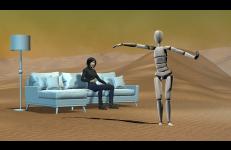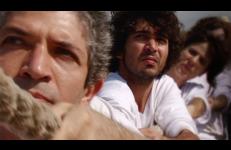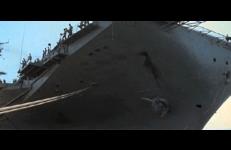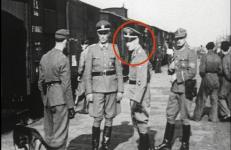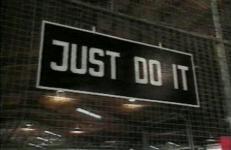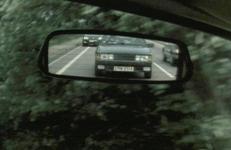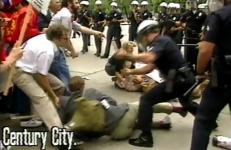In the late 1960s Kim Jong Il guaranteed his succession as the Dear Leader of North Korea by adapting his father's Juche (pronounced choo-CHAY) philosophy to propaganda, film and art. Translated as self-reliance, Juche is a hybrid of Confucian and authoritarian Stalinist Pseudo-socialism. The film is about a South Korean video artist who comes to a North Korean art residency to help bring Juche cinema into the 21st Century.
Labor
Originally part of a multi-media installation at the Everhart Museum in Scranton, Pennsylvania, King Anthracite documents the lives, work, and early deaths of Lithuanian immigrants (including Kybartas’ ancestors) who mined the Pennsylvania coalfields at the turn of century. Oral histories of miners detail their impressions of the United States and the hardships they encountered, including black lung disease and other occupational hazards that turned wives into widows and children into orphans.
Eerily drifting through soft fades, superimposed images, close-ups, and visual feedback, this tape follows less a narrative structure and more a stringing together of seemingly random activities, set against two very different soundtracks. The video opens with David Cort reclining on the ground as psychedelic rock plays in the background. Two shots alternate between frontal and profile as he lazily plays with his beard and face – the streams of footage melding together with the use of live editing.
Lead is a tale of an early 20th Century Robin Hood, based on a story by James Williams, involving jumping trains and throwing coal off for needy Southerners.
Cast: Chris Barkley, Hassen Mahamud, Kenny West, James Williams. Cinematography: Jonathan Taee. Sound: Ayesha Ninan.
This title is only available on Broad Daylight and Other Times: Selected Works of Kevin Jerome Everson.
The “greca”, the meander, is the main symbol weaved in the textiles made by the Navarro sisters, from Santo Tomás Jalieza, México. A geometrical form of an endless braid of diamonds, the “greca” represents corn (an entity worshiped by the pre-hispanic civilisations of Mesoamerica). It stands for sustenance, but materialises as well the feminine power of producing abundance and fertility - the textiles displaying this ongoing motives could be read as invocations for life and growth.
Lighthouse is about the labor system and the factory town in Southern China and how individualism is influenced by the social and political infrastructure. Guangdong District is the largest Metropolitan area in one of China's wealthiest provinces, and one of its cities, Guangzhou, attracts farmers from the countryside looking for factory work. The viewer is led to actively compose narratives through the poetic and the sublime images. It opens borders that separate cultural, linguistic and historical differences in the global labor systems.
Blending live action staged as if in a dollhouse with rarely seen archival footage from the National Archives, the fantastically true story of how America entered WWI is told. Through vibrant historical characters like labor leader Elizabeth Gurley Flynn and German naval officer Franz von Rintelen this loose adaptation of John dos Passos’ 42nd Parallel, explores the timeless issues of radical labor politics and the domestic effects of war.
Kipnis describes this tape as "an appropriation of the aesthetics of both late capitalism and early Soviet cinema—MTV meets Eisenstein—reconstructing Karl Marx for the video age.” She presents a postmodern lecture delivered by a chorus of drag queens on the unexpected corelations between Marx’s theories and the carbuncles that plagued the body of the rotund thinker for over thirty years. Marx’s erupting, diseased body is juxtaposed with the “body politic", and posited as a symbol of contemporary society proceeding the failed revolutions of the late 1960s.
This film originated as an expanded portrait of artist Carol Bove as she created four monumental sculptures commissioned by the Metropolitan Museum of Art. One week after filming began, New York City went into its first pandemic lockdown. Filmed against the backdrop of the progressing pandemic, Medium evolved into a meditation on materiality and the artist as a medium through which ideas move into the world.
Looking like a 1970’s version of “Rosie the Riveter”, Mogul takes on the persona of an artist who makes a living posting billboards on the Sunset Strip in Hollywood. As Mogul recounts her climb up the billboard “ladder”, she realizes that the only way to truly make a “name” for herself is to create her own billboard. And so she does.
A brief glimpse of a confessional detour during a pictorial drift.
The everyday performance of domestic labor is teleported into a surreal game world where an emotionally responsive AI chatbot provides no answers.
In this world, motion capture technology translates movement into data that can be unbound from the human body. Yvonne’s No Manifesto becomes a framework for understanding the existential impact of this new dataset. What happens to movement when it is divorced from affect and feeling? What happens to dance without the basic premise of embodiment and breath?
Hirsch’s most ambitious film to date and the pinnacle of his trilogy, Nothing New depicts the epic rescue mission of a man whose parachute is caught on electricity power lines. Involving hundreds of participants in a desolate field facing the Jordanian border in the Jordan Valley of Israel, this communal cinematic endeavor aims to re-unite, if only for a brief moment, the collective spirit of the socialist Kibbutz movement in Israel, a movement that has undergone significant ideological modifications.
The Observers portrays one of the world's last staffed weather observatories in two different seasons. Extreme and unpredictable, the land and sky of Mount Washington, New Hampshire form a varying frame for a climatologist as she goes about the solitary and steadfast work of measuring and recording the weather.
In the beginning was the weave, and the transmission of its workings, a curse of mortality—so ends Quantum Creole with the fabulous words of the Papel weaver, Zé Interpretador.
Ray Lowden keeps seventy-two large birds of prey, five deer and some wallabies at his place in Northumberland, England. He’s had ten days off in twelve years and loves what he does. The film is a little homage to his variously coy, imperious, curious, stubborn and comic raptor menagerie.
-- Deborah Stratman
Respite consists of silent black-and-white films shot at Westerbork, a Dutch refugee camp established in 1939 for Jews fleeing Germany. In 1942, after the occupation of Holland, its function was reversed by the Nazis and it became a 'transit camp.' In 1944, the camp commander commissioned a film, shot by a photographer, Rudolph Breslauer.
Short Circuit is an experimental documentary—a semi-autobiographical rant that challenges the obsolescence of human labor at the vortex of the machine and digital ages. Through a flow of images, text, and sound, the mechanical and the electronic clash in the thought processes of our protagonist. Is the global revolt of the machines at hand?
A nostalgic glazier shows off his knowledge and expounds his theories. Taking glassmaking processes and history as its central theme, Slow Glass explores ideas about memory, perception and change.
Sportello Quattro, filmed during a residency at the American Academy in Rome, is about immigration, work and community among people of color in contemporary Rome, Italy.
Cast: Joseph Bayorha.
This title is only available on Broad Daylight and Other Times: Selected Works of Kevin Jerome Everson.
An investigative documentary on police brutality that uses the Rodney King incident as a springboard to analyze the inner workings of the LAPD under the leadership of former police chief, Daryl Gates. Containing hard-hitting footage of police violence, the tape also depicts communities working against the daily occupation of their neighborhoods. Through interviews with LAPD officers and supervisors, the tape reveals what life is like behind the “thin blue line” and documents a national crisis of violence.
An investigative documentary on police brutality that uses the Rodney King incident as a springboard to analyze the inner workings of the LAPD under the leadership of former police chief, Daryl Gates. Containing hard-hitting footage of police violence, the tape also depicts communities working against the daily occupation of their neighborhoods. Through interviews with LAPD officers and supervisors, the tape reveals what life is like behind the “thin blue line” and documents a national crisis of violence.
Strike Anywhere is a video essay that takes as its point of departure Swedish "Match King" Ivar Kreuger, whose privatization of financial crisis management strategies bears a direct relation to late-20th Century policies implemented by the IMF and WTO. Between 1917 and 1932, Kreuger capitalized on shifts in global financial markets to control over 200 companies and establish matchstick monopolies in at least 34 countries. At the height of his success, Ivar Kreuger was worth approximately 30 million Swedish kronor (the equivalent of 100 billion USD today).
Strike Anywhere is a video essay that takes as its point of departure Swedish "Match King" Ivar Kreuger, whose privatization of financial crisis management strategies bears a direct relation to late-20th Century policies implemented by the IMF and WTO. Between 1917 and 1932, Kreuger capitalized on shifts in global financial markets to control over 200 companies and establish matchstick monopolies in at least 34 countries. At the height of his success, Ivar Kreuger was worth approximately 30 million Swedish kronor (the equivalent of 100 billion USD today).
Tochka depicts a journey made by anonymous group through a rough landscape. After many hardships, they arrive at a shallow ravine where they decide to build a rickety wooden bridge so that they can cross to the other side. Utilizing low-tech handmade machinery and a cumbersome logic, the film questions collective ideology and the process of making art as a community.






